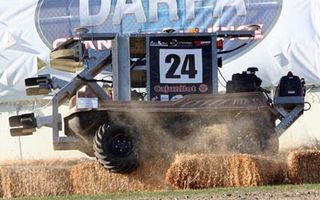DARPA Grand Challenge update #1: Qualification day 1 results
Fontana (CA) - Facing hot temperatures, high winds and an occasional dust storm, the 43 DARPA Grand Challenge teams entered the qualification round at the Fontana Speedway. The first day seemed to resemble more a destruction derby than a race. Many of the autonomous vehicles hit parked cars and hay bales, but in the end a good chunk of the teams successfully completed the course.
It was a rocky start for the DARPA Grand Challenge qualifying session, which began in late afternoon on Tuesday. DARPA organizers were quite busy with doing static and dynamic safety inspections of every car before it went out on the racetrack. The static check is basically a walk-around of the vehicle, while the dynamic check has the vehicle in motion at 10 mph.
By mid-afternoon, the first 16 teams moved their cars into official qualifying with seven teams passing the first test. All is not lost for the unsuccessful teams as they get more chances to complete the course. Every vehicle must have a functional E-Stop that immediately shuts down the vehicle.

20 the total 43 teams will make it to the actual race and DARPA expects that there is a 25 percent chance of a vehicle winning the race and taking home the $2million cash price. One of the major upcoming challenging is a "dynamic" race course. If many vehicles are failing the course, obstacles could be taken out to make it easier. Of course, if every vehicle is passing the opposite will happen, DARPA said.
An overview of qualification events:
Cornell University's Spider almost clipped the first metal sheet wall, but avoided all the obstacles after that. It flew down so fast down the straight away portion that we could hear the wind turbulence from about 100 yards away. Spider finished the course.
Carnegie Mellon's Red Team Too's H1lander completed the course without any difficulty and it looked to be the smoothest vehicle so far.
Stay on the Cutting Edge
Join the experts who read Tom's Hardware for the inside track on enthusiast PC tech news — and have for over 25 years. We'll send breaking news and in-depth reviews of CPUs, GPUs, AI, maker hardware and more straight to your inbox.
Team Jefferson's Tommy vehicle looks like an armored hot dog or maybe an oddly shaped egg. According to DARPA officials the on-board computer only costs $200. Tommy stuck some hay bales which cause them to fly up in the air and wedge under the vehicle. The computer apparently didn't think anything was wrong and revved up the engine to maximum. The wheels began to burn and spew smoke, which quickly floated into the press viewing area.
Team Banzai's Racer X vehicle also did not finish the course. The team made a unique emergency stop as to not ruin the beauty of the blue VW Touareg. While other teams have a big red button as their E-Stop, Team Banzai engineered the rear passenger door handles as the E-Stop - You pull the handle, and the vehicle dies.
Racer X was very hesitant during obstacle avoidance and stopped/restarted several times. From our vantage point, it looked like it hit at least two cones and finally was stopped for good.
The Grey Team's vehicle was called the GreyBot until recently. In memory of the tragedy caused by Hurricane Katrina, the Louisiana based team renamed the robot Cat 5. The vehicle did well on the obstacle avoidance, but it stalled out in the straight away.
Team CajunBot broke a chain the day before qualifications and went to extreme lengths to get a new one. At four in the morning, the team called and woke up a San Diego based ATV dealer. The dealer agreed to provide the team a new chain and met a team member on the 15 freeway near San Diego.
The CajunBot vehicle did fairly well in the early portion of their run, easily clearing obstacles in a herky-jerky fashion. The six wheeled (three on each side) vehicle doesn't make smooth turns, because the center wheel tends to be a pivot point. On the straight-away portion, the little vehicle revved up to decent speed. Unfortunately, CajunBot became disabled when its front left wheel got wedge up on a hay bale.
Team TerraMax's 36000 pound truck took a very long time in completing the course. The wide width of the truck complicates some of the obstacle avoidance. At the starting gate, it did an immediate right turn and clipped the cement wall, knocking it back several inches. Officials yelled, "Watch Out!" to the workers in the next gate.
The first set of obstacles were two metal sheet walls spaced just far enough apart for TerraMax to drive through. While most of the other vehicles had no problems avoiding these walls, TerraMax spent around four minutes going forward and backing up, before finally clearing the obstacle.
Successful teams of the first qualification round: Mojovaton, Stanford, CIMAR, Team Terramax, Red Team Too, Cornell University, Intelligent Vehicle Safety tech finished
Teams failing the qualification: Virginia Tech - Rocky, Autonosys, Golem, Sciautonics, Mitre, Cajunbot, Team Jefferson, Banzai, Grey Team
Stay tuned to THG for the latest updates on the DARPA Grand Challenge Qualifications and Race.
Most Popular


